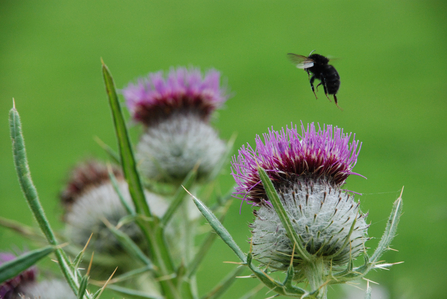
Common thistle and bee by Zsuzsanna Bird
Thistles provide a succession of micro-environments and food for a range of birds such as siskin and insects feeding on green leaves, flower heads, dead heads and stems.
However, in some grassland situations creeping thistle and spear thistle in particular can become a problem – both are injurious weeds. Other thistles may be rare, valuable to wildlife and unlikely to cause problems.
Thistles for wildlife
The goldfinch is the bird most commonly associated with thistles, the seeds of which make up one third of its diet. Within the same genera are greenfinch, siskin, linnet, twite and redpoll, which eat thistle seeds and use thistledown in the nest.
Butterflies including painted lady larvae feed on the leaves. Other butterflies such as the white letter hairstreak, peacock and meadow brown use thistles as a nectar source, penetrating the long tubular flowers with their probing proboscis.
Other invertebrates including bees feed on nectar and use the micro-habitats in and on thistles. The flower head provides the greatest diversity of insects and the stem is particularly important as an over-wintering habitat.
How thistles spread
A creeping thistle problem should not develop in a dense, well-managed sward of perennial grasses but when it does occur it can be very invasive. It only rarely propagates itself by seed – the fluffy fruit heads often have no fertile fruits. Instead, its root propagation is very efficient – fragments of rhizome can remain dormant in the soil for years and then appear when there is a gap in the sward. A small cutting can spread into a 20m patch in just two years.
Trials have shown that even 12mm cut lengths of root had a 100% success rate at producing new plants. Spear thistle does, however, depend on wind dispersal for seeds on a parachute of hairs or pappus, but seeds usually fall to earth in the first 40m.
Thistle control options
Timing of thistle control is crucial and the method used will vary according to the site:
• Prevention is better than cure – aim to maintain a wellmanaged perennial sward without gaps. Avoid overgrazing (especially in the winter) and poaching which opens up gaps in the sward into which thistles can spread
• Prevent sites from drying out. Raise water levels where sites have dried out – thistles are not generally a problem on damp grassland
• No control strategy should rely on use of herbicides alone and needs to be integrated, particularly with good grazing practice and mechanical topping (to weaken plants and prevent flowering and seed spread), if it is to be effective
Look after the non-invasive thistles
There are 12 thistle species found in Suffolk. Apart from spear and creeping thistle the other thistles should not be regarded as problem species in grassland in Suffolk – indeed, they are valuable to wildlife and include the following:
• Marsh thistle – biennial found in marshes and other damp areas
• Welted thistle – biennial of streamsides and damp hedgerows. Small flower heads
• Musk thistle – biennial of dry pastures, waysides, especially on chalky or sandy soil. Solitary nodding heads
• Slender thistle – found in waste places and along the Suffolk coast.
Some thistle control options for different grassland situations
|
Method of thistle control |
Suitable situation |
Objective |
| Cutting by tractor-mounted cutter, scythe or strimmer. |
Where infestations of creeping or spear thistle are small, bird nesting is not an issue, equipment and labour are available and where total control is neither desirable nor necessary. |
Timing of cutting is crucial. This should take place just before the flower bud turns purple, as this is when the maximum reserves from the thistle roots are being used to produce seed. This old saying often proves true: ‘Cut a thistle in June, it’s a month too soon; Cut a thistle in July it will surely die.’ Remove cuttings to prevent seed ripening. |
| Mechanical control with ‘thistle spear’ or spade. |
For spear thistles only – this method simply encourages spread with creeping thistle. |
Digging out the root or destroying the rosette can be very effective with spear thistles. |
To discuss other options, please contact one of our advisors.
